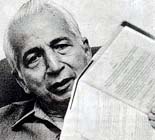Commentary / Mani Shankar Aiyar
Judges on the scale
 One is an additional session judge. The other a former chief justice
of the Supreme Court. One writes prose dry as a fallen autumn
leaf. The other soars to purple heights. One is self-effacing.
The other assertive. One has been pulled up by the Delhi high
court and Parliament for letting his judicial pen run away with
him. The other is a model of judicial rectitude. The contrast
could not be more stark. Yet, what unites them is that neither
has been able to pinpoint who the murderers were.
One is an additional session judge. The other a former chief justice
of the Supreme Court. One writes prose dry as a fallen autumn
leaf. The other soars to purple heights. One is self-effacing.
The other assertive. One has been pulled up by the Delhi high
court and Parliament for letting his judicial pen run away with
him. The other is a model of judicial rectitude. The contrast
could not be more stark. Yet, what unites them is that neither
has been able to pinpoint who the murderers were.
Justice Ranganath Misra was asked to enquire into the riots of
1984. Judge Dhingra had before him 93 accused. Justice Misra
concluded that the 'uncontrolled riots of 31 October transformed
themselves into riotous activity with the participation and monitoring
thereof by anti-socials.' He was unable to identify these
'anti-socials' beyond noting that 'there was organised
violence at Delhi and that was done by the anti-social elements.'
What he underlined was that 'in the riots, thousands of people
who did not really belong to the classification of anti-socials
did participate.'
Justice Misra quotes various authorities
to show that in the kind of atmosphere that prevailed, normally
law abiding citizens have been known to turn vicious and atavistic.
Who, specifically, these anti-socials were and who, specifically,
these temporarily insane ordinary citizens were, Justice Ranganath
Misra was not able to pinpoint. That was a matter for the courts.
The worst of the rioting took place in Trilokpuri, on the east
bank of the Yamuna. Out of the 2,800 people killed in Delhi in
the riots, 400 belonged to Trilokpuri alone. One hundred and seven persons
were arrested from the area. 93 were brought
to trial. 89 (some newspaper reports say 88) have been
sentenced by Judge Dhingra. Not one has been sentenced for murder.
For all the flow of words in the Dhingra judgment, the one fact
that we must focus on is that, as a trial judge, he has been unable
to find evidence enough to convict anyone of murder. And surely
it is the loss of nearly 3,000 precious lives that must claim
our first attention and priority. If there were no dead bodies,
only torched dwellings and some manhandling, one might have felt
that the ends of justice had been met by sentence for 'the
destruction of houses by fire and explosives' (Section 436
of the Criminal Procedure Code), 'rioting' (Section 147) and the violation
of curfew orders.
But the rest is surely death. With at least 400 dead in Trilokpuri
alone, why has Judge Dhingra failed to sentence any one of the
93 accused, all of whom are from Trilokpuri, for murder? Presumably
because he was not able to find enough evidence that could connect
any of the 93 accused to a specific dead body.
That, as far as I can make out, was also Justice Ranganath Misra's
problem. All the thousands of affidavits signed were pointers,
none evidence conclusive enough to say, 'This is the man!'
That, under the rule of law, could only be done after the due
process of the law had taken its cumbersome course. Twelve years
after the heinous crimes were committed, the due process of the
law brought 93 persons to Judge Dhingra's court for conviction.
He convicted 89 (or 88) of them -- but not one for murder. It
still remains unproved who, specifically, took these thousands
of precious, innocent lives.
His failure to find even one murderer among the close on one hundred
apprehended and brought before him has, however, not inhibited
Judge Dhingra from expressing himself at length on the crimes
of those not arraigned before him for trial. 'Those who engineered
the riots and made these people their tools,' says Judge
Dhingra, 'are still at large... the real culprits are the
administration, the police and their 'political masters'.
|





 One is an additional session judge. The other a former chief justice
of the Supreme Court. One writes prose dry as a fallen autumn
leaf. The other soars to purple heights. One is self-effacing.
The other assertive. One has been pulled up by the Delhi high
court and Parliament for letting his judicial pen run away with
him. The other is a model of judicial rectitude. The contrast
could not be more stark. Yet, what unites them is that neither
has been able to pinpoint who the murderers were.
One is an additional session judge. The other a former chief justice
of the Supreme Court. One writes prose dry as a fallen autumn
leaf. The other soars to purple heights. One is self-effacing.
The other assertive. One has been pulled up by the Delhi high
court and Parliament for letting his judicial pen run away with
him. The other is a model of judicial rectitude. The contrast
could not be more stark. Yet, what unites them is that neither
has been able to pinpoint who the murderers were.